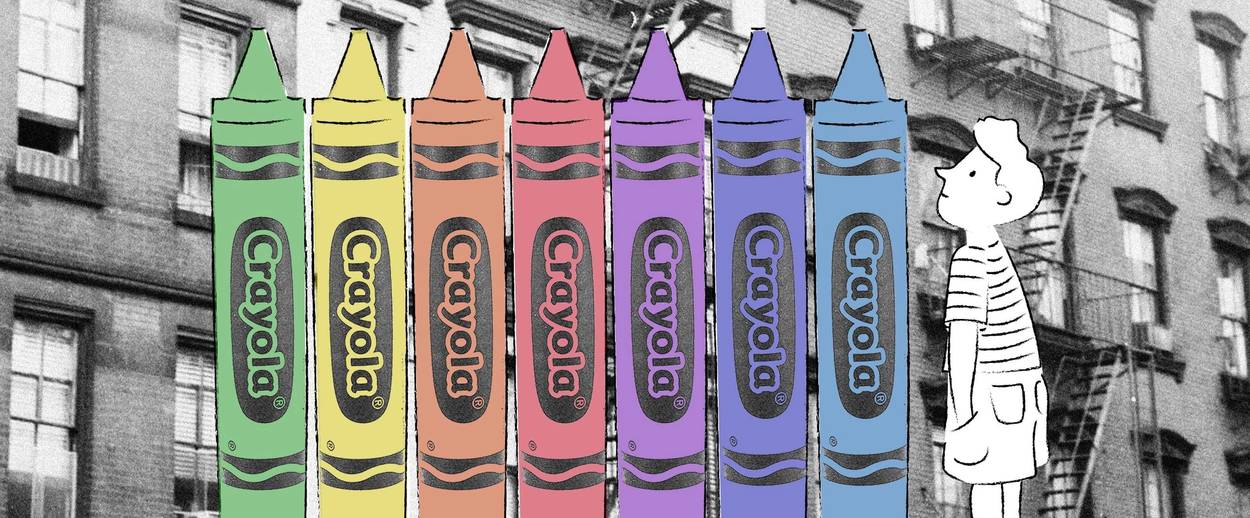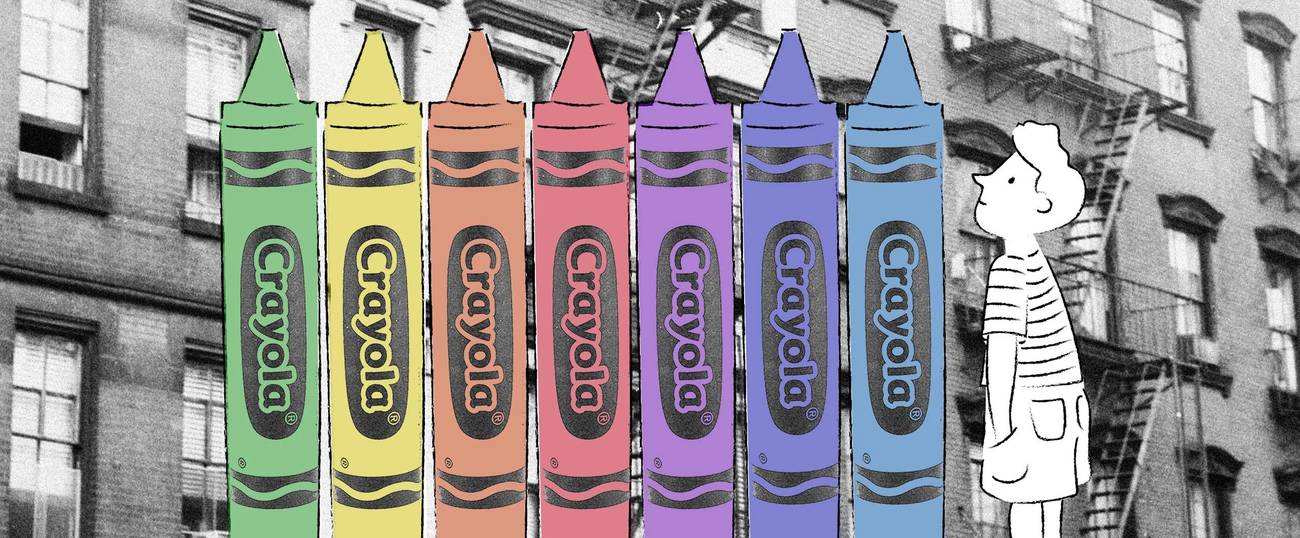The Smell of Crayons
Lessons from the first day of class on Manhattan’s Upper West Side in the early 1950s




I had to smile the other day when I read in the Times that Crayola was retiring the dandelion color from its crayon palette and allowing it to join 12 other retired shades like maize, raw umber, and mulberry. When crayons were important to me, I learned the hard way that there were such colors.
It’s curious how smells, more than sights and sounds, are the Madeleine that unlocks the pleasures and torments of childhood. The whiff of a jar of peanut butter recalls for me an American treat my Poland-raised mother occasionally prepared. The musty odor of a pile of prayer shawls brings back the yellowed tallis my father wrapped himself in whenever he went to shul, with its mystical evocation of the divine. The acrid aroma of a strong cigarette recalls a magnetic elfin refugee friend of my parents, and the hacking cough until he died. And the cloyingly sweet fragrance of a box of crayons brings back my early school days in the early 1950s in a yeshiva on the Upper West Side of Manhattan.
In the first grade, I was a new refugee—very much like the Somali and Syrian children now being blocked from entering the country. My mother had grown up in the resort town of Otwock outside Warsaw with a father who was both a melamed tutoring boys in cheder and chazzan leading services on Rosh Hashanah and Yom Kippur. So it was understandable that she wanted my brother Josh and me to have a Torah education. Manhattan Day School, the yeshiva she chose, was then located in a red brick, fortress-like Victorian institution, two blocks away from our tenement apartment on 102 Street and Manhattan Avenue, one block from Central Park.
The blocks nearby were peopled with blue-collar Irish and Italian families, recently immigrated Holocaust survivors and just as recently arrived migrants from Puerto Rico. But Manhattan Day School had a contingent of more well-heeled children who lived in the tall, stout buildings along West End Avenue, Riverside Drive, and Central Park West. Later I was to find out they, too, were refugees, though many had immigrated just before the Nazis took over Germany, Austria, Belgium, Holland, and France. That extra head start in America allowed them, by working hard, to make themselves flush again, and restore some of their status. Without knowing their background stories, I felt the contrast in the bus rides they took to school and in such things as the slick yellow mackintoshes they could afford to wear on rainy days.
On my first day of class, the teacher, Mrs. Martin, asked the pupils to bring in supply kits—pencils, glue, scissors, an eraser, a ruler, a sharpener, and crayons. My mother was distressed by the expense but took up the challenge. From the cookie tin that was her sewing kit, she pulled out a pair of black-handled scissors for me to use then led my brother Josh and me around the corner to the M.H. Lamston’s five-and-dime store on Columbus Avenue. The counters were heaped with more goods than I had ever seen in one place– a rainbow of thread spools, a latticework of red and pink lipsticks, tanks of flitting goldfish, bobby pins, picture frames, screwdrivers, house plants. Dazzled by this American cornucopia, we had to remind ourselves that we were here for school supplies and nothing else.
My mother, who found season work sewing hat brims in a downtown factory to supplement my father’s meager income from working in a textile plant, picked out the smallest box of crayons—eight basic colors to the box. She examined the price tag before putting it in our cart. I found a six-inch-long ruler, a fresh pink eraser with its astringent rubber smell, and a bottle of whiskey-colored glue that I tilted up and down to see the air bubble float.
“For what do you need three pencils?” my mother said irritably in her homespun argot, a mix of Yiddish and newly-acquired English words. “Buy one, and when you finish it, I’ll buy you another.”
Josh undertook this expedition with delight. In those days nothing seemed to make him happier than being alongside his older brother, joining him in whatever he had to do. With good humor, he stretched up on tiptoes to the counter to gather up extra pencils and erasers. until my mother scolded him to put them back.
At the cashier’s, I could see it pinched her to turn over the two dollars she fished from her clasp purse, dollars she or my father had worked two hours to earn. But I walked out of the store puffed up, proudly clasping the brown bag of supplies to my chest. Despite her resistance, my mother seemed pleased as well.
“I don’t want you to feel inferior to no one in class,” she said, using an English word she must have picked up on some Dear Abby broadcast. Radio was her one entertainment, though she mostly listened to pop music and in her rich soprano sang along to such song of the period as “Hernando’s Hideaway,” “Glow Worm,” and “Autumn Leaves.”
Just before we reached our building, on a sudden impulse she shepherded Josh and me around the corner to the candy store. The narrow cluttered basement store was owned by two survivors—we called them greeners—Mr. Nugel and Mr. Zlotogorski (we called all our parents’ friends with an honorific, European-style). The two refugees had recently purchased the store and were now chained to long, draining days, rising before dawn to haul in the bundles of morning newspapers and dispensing egg creams and cigarettes to the teenagers hanging out until after nightfall. Grinning with mischief, Mr. Zlotogorski picked out the coup de grace to my supply kit—an empty Dutch Masters cigar box that had sat on the shelves with a lone remaining cigar. He blew out the shreds of tobacco and handed it to me.
“There,” he said, “with a sardonic chortle. “Now you got a fancy box for school.”
How laughable indeed this fuss made over a supply kit must have seemed to him and my mother, people who were glad, as children, to have shoes with which to walk to school and who went on to endure much greater shocks. But to me the whole project was intoxicating: the cigar box with its portrait of a scrum of Dutch burghers; the crayons—red, blue, green, purple, yellow, green, black, and white—lined up trimly, their shiny funnel points at attention like soldiers in a regimental parade. I arranged the supplies in a pleasing tableau and fastened it with a rubber band. These tools were mine for my vocation, just as my father had his leather knife, hammer, and last for repairing shoes, and my mother had her tin of needles, threads, and a thimble.
But the next day in class, an event I hoped would be a triumph, a chance to display the luxurious kit that I had assembled, turned out to be a debacle. Mrs. Martin asked the students to take out their kits. I put mine on the desk with welling pride, knowing I had each item she wanted, aching only for the nod of her approval. But as she weaved through the rows on her inspection tour, I glimpsed my classmate Gloria showing her supplies off to the girl next to her. Gloria was the daughter of a wealthy prewar German refugee, and the generosity of families like hers was indirectly making it possible for me and other poorer students to attend school for as little as $10 a month. She not only had a packed tin of supplies but a separate box of Crayola crayons, 64 of them, arrayed in orderly tiers. She drew out such subtle and exotic shades as salmon, apricot, mulberry, flesh, olive, silver, gold, melon, copper, and lavender.
I could never match her assortment. My regiment of soldiers felt like a ragged platoon.
When Tennessee Williams wrote his first masterpiece, The Glass Menagerie, he called it a “memory play,” which he contrasted to more realistic dramas. He had his narrator, Tom, add: “I give you truth in the pleasant disguise of illusion.” Distant memories, with minor crises we can look back with tenderness and smile at, often are truths in the disguise of illusions; crayon sketches, if you will—gauzy, vaporous experiences with sharply-edged resonances. Those moments define something about the vulnerable people we were, and the feelings we’ve had to struggle with and surmount.
The article was adapted from the 2001 memoir Displaced Persons: Growing Up American After the Holocaust.
***
Like this article? Sign up for our Daily Digest to get Tablet Magazine’s new content in your inbox each morning.
Joseph Berger retired from The New York Times in December 2014 after thirty years as a reporter and editor. He is currently writing a biography of Elie Wiesel.